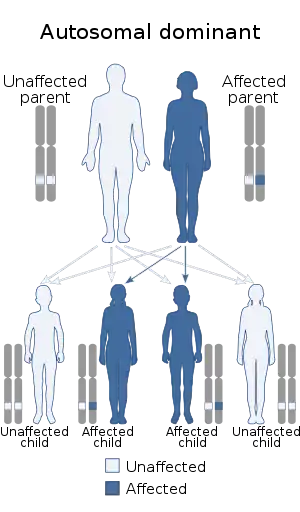Sprengel's deformity
Sprengel's deformity (also known as high scapula or congenital high scapula) is a rare congenital skeletal abnormality where a person has one shoulder blade that sits higher on the back than the other. The deformity is due to a failure in early fetal development where the shoulder fails to descend properly from the neck to its final position. The deformity is commonly associated with other conditions, most notably Klippel–Feil syndrome, congenital scoliosis, including cervical scoliosis, fused ribs, the presence of an omovertebral bone (an extra bone between the scapula and a cervical vertebra) and spina bifida. The left shoulder is the most commonly affected shoulder, but the condition can be bilateral, meaning that both shoulders are affected.
| Sprengel's deformity | |
|---|---|
| Other names | Sprengel deformity, Sprengel's shoulder, Sprengel shoulder, high scapula |
 | |
| Sprengel's deformity, showing a higher right-sided shoulder blade | |
| Specialty | Medical genetics |
| Types | Muscular forms |
About 75% of all observed cases are girls. Treatment includes surgery in early childhood and physical therapy. Surgical treatment in adulthood is complicated by the risk of nerve damage when removing the omovertebral bone and when stretching the muscle tissue during relocation of the shoulder.
Presentation

The scapula is small and rotated so that its inferior edge points toward the spine. Sometimes a bony connection is present between the elevated scapula and one of the cervical vertebrae, usually C5 or C6. This connection is known as an omovertebral bone.
There is a high correlation between Sprengel's deformity and Klippel–Feil syndrome.
Diagnosis

Diagnosis is clinical and can be confirmed by instrumental diagnostics like conventional radiography and CT scan. It may be indicated to perform a genetic analysis, as the deformity may occur under other conditions (see Klippel–Feil syndrome).
Eponym
It is named for German surgeon Otto Sprengel, who described it in 1891.[1][2]
References
- synd/2450 at Who Named It?
- O. K. Sprengel. Die angeborene Verschiebung des Schulterblattes nach oben. Archiv für klinische Chirurgie, Berlin, 1891, 42: 545-549.
External links
| Classification | |
|---|---|
| External resources |